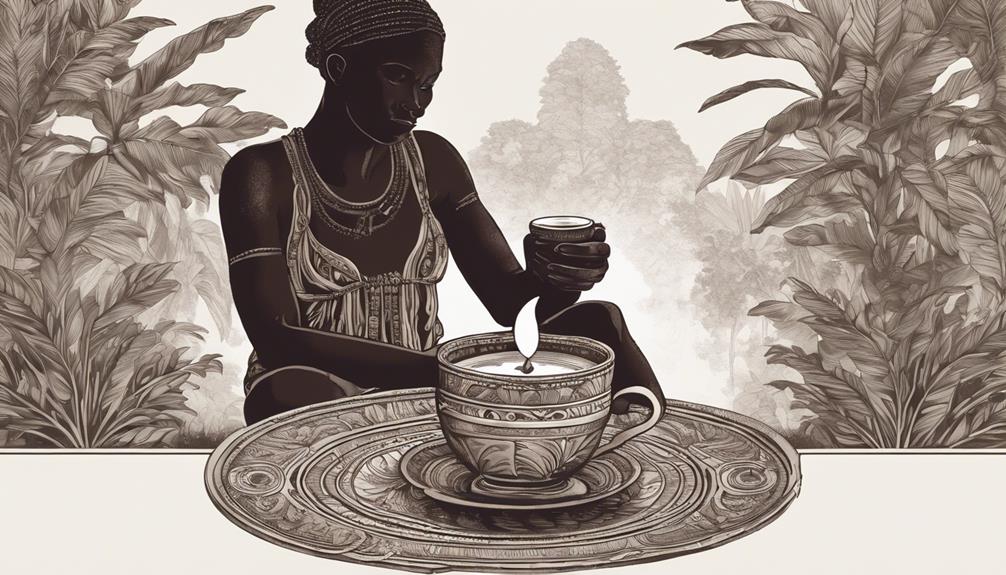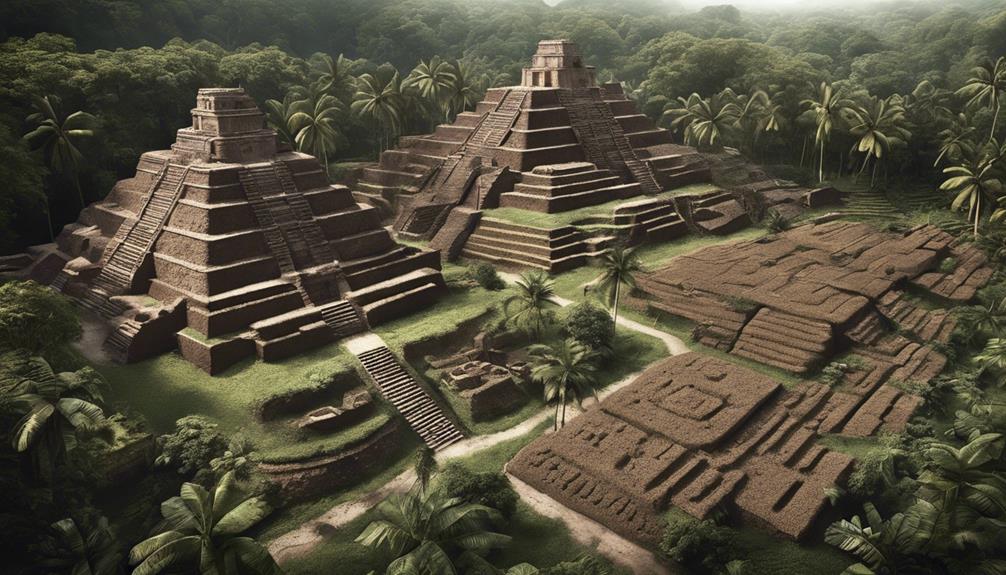Ceremonial grade cacao, highly valued by ancient Meso-American civilizations such as the Mayans and Aztecs, carries a unique importance as a sacred plant utilized in ceremonies and everyday living. The spiritual and healing qualities of cacao are deeply respected, aiding in emotional healing, sparking creativity, and decreasing stress. By participating in cacao ceremonies, unity and community are nurtured, fostering stronger relationships and facilitating emotional healing and personal growth.
This sacred plant's qualities connect individuals to higher consciousness and inner healing, creating a space for mindfulness, emotional healing, and personal growth like no other. Understanding the special qualities of ceremonial grade cacao reveals a world of spiritual connection and healing awaiting exploration.
Key Takeaways
- Ceremonial cacao is revered as the 'food of the gods' for its spiritual and healing properties.
- Enhances emotional healing, creativity, and cardiovascular health in ceremonies.
- Facilitates mindfulness, inner peace, and emotional awareness.
- Fosters unity, community, and deep interpersonal connections.
- Blends ancient practices with modern preferences for personal growth and spiritual exploration.
Origins of Ceremonial Cacao
Exploring the origins of ceremonial cacao, one investigates the ancient practices of Meso-American cultures, particularly the Mayans and Aztecs. For these civilizations, cacao was more than just a beverage; it was a sacred plant intertwined with their daily lives and spiritual beliefs.
The Mayans, in particular, meticulously documented elaborate Cacao Rituals, highlighting the significance of cacao in their culture. They believed that cacao was a divine gift from the gods, bestowing wisdom and strength upon those who consumed it during ceremonies. Similarly, the Aztecs also revered cacao, using it in various rituals and even valuing it as a form of currency.
The ceremonies involving cacao were deeply ingrained in the social and religious fabric of these ancient societies, showcasing the profound respect they had for this sacred plant. Through these rituals, the Mayans and Aztecs honored cacao's divine essence and recognized its power to connect them with the spiritual domain.
Spiritual Significance

Ceremonial grade cacao carries deep spiritual significance, linking back to ancient civilizations like the Mayans and Aztecs. It was revered as the 'food of the gods' and utilized in sacred rituals and ceremonies.
Engaging in cacao ceremonies can lead to a profound connection to higher consciousness and inner healing.
Sacred Rituals With Cacao
Incorporating ceremonial-grade cacao into spiritual practices enhances the depth of connection to oneself and the divine. Ancient civilizations like the Mayans and Aztecs revered cacao, considering it the 'food of the gods' essential in sacred rituals. These rituals aimed to ground the mind, body, and spirit, fostering a profound spiritual connection.
Today, modern cacao ceremonies echo the transformative qualities of these ancient practices, opening new creative pathways and promoting mindfulness. Engaging in these sacred rituals with cacao can bring about unity and connection among participants, encouraging a sense of oneness with the universe.
Embrace the sacred tradition of cacao ceremonies to deepen your spiritual journey and uncover the profound wisdom that cacao holds.
Healing Properties of Cacao
In spiritual practices, cacao's healing properties play an essential role in emotional release and energy alignment.
- Cacao has been utilized for emotional healing and releasing energetic blockages in spiritual ceremonies.
- Participants in cacao ceremonies often experience deepened connections and a sense of unity with others.
- Cacao consumption in ceremonies can enhance meditation, mindfulness, reduce stress, and induce relaxation.
- Regular consumption of ceremonial cacao has been associated with boosted creativity and improved cardiovascular health.
Cacao ceremonies offer a space for individuals to engage in profound emotional healing, paving the way for a deeper connection to oneself and others. Through the sacred ritual of cacao consumption, one can discover new levels of spiritual awareness and experience a profound sense of well-being.
Connection to Higher Consciousness
Often revered for its role in facilitating a connection to higher consciousness during spiritual practices, ceremonial grade cacao holds deep spiritual significance rooted in ancient Meso-American traditions. Drinking ceremonial cacao is more than just a beverage; it is a sacred tool used to elevate one's spiritual experiences and tap into higher realms of awareness. This special cacao is believed to assist individuals in reaching heightened states of consciousness and gaining profound insights into the self. By engaging in ceremonial rituals centered around the consumption of this sacred drink, practitioners aim to harmonize their mind, body, and spirit, ultimately fostering a deeper connection to the divine. Embracing ceremonial grade cacao as a conduit to higher consciousness is a way to honor ancient traditions and explore the depths of spiritual significance.
| Ceremonial Cacao Drink | Spiritual Significance | Higher Consciousness |
|---|---|---|
| Facilitates spiritual connection | Rooted in ancient traditions | Elevates awareness |
| Sacred tool for spiritual experiences | Opens pathways to self-awareness | Fosters profound insights |
| Enhances meditation practices | Harmonizes mind, body, and spirit | Connects to the divine |
Emotional Healing Properties

Ceremonial grade cacao possesses remarkable emotional healing properties, aiding in the soothing of emotional wounds and enhancing inner peace.
The theobromine and anandamide found in ceremonial cacao can contribute to feelings of relaxation, joy, and emotional well-being.
Engaging in cacao ceremonies can facilitate a journey of self-discovery, allowing for heightened emotional awareness and fostering personal growth.
Soothing Emotional Wounds
Exploring the emotional healing properties of ceremonial grade cacao reveals its ability to foster relaxation and calmness, supporting the processing of emotional wounds. When consumed mindfully and intentionally, ceremonial cacao can facilitate emotional healing through its unique components.
Here are some ways it can help soothe emotional wounds:
- Enhancing Mood: The theobromine and anandamide in cacao can uplift mood and promote a sense of well-being.
- Reducing Stress: Ceremonial cacao can aid in stress reduction, allowing for a more peaceful state of mind.
- Releasing Blockages: Consuming cacao in a mindful way can assist in releasing emotional blockages and fostering inner healing.
- Creating Safe Spaces: Cacao ceremonies provide a nurturing environment for emotional healing, encouraging a deeper connection with one's emotions.
Enhancing Inner Peace
Enhancing inner peace through the emotional healing properties of ceremonial grade cacao involves tapping into its unique compounds for a profound sense of tranquility and harmony. During cacao ceremonies, the theobromine and anandamide in the cacao can help release emotional blockages, fostering a deep sense of emotional healing.
By consuming ceremonial grade cacao mindfully in these ceremonies, individuals can enhance their emotional healing processes and experience a greater sense of inner peace. The ritualistic nature of cacao ceremonies creates a safe and sacred space where participants can address and work through emotional challenges, leading to feelings of calm, relaxation, and emotional release.
Engaging in cacao ceremonies can be a powerful tool for cultivating inner peace and emotional well-being.
Facilitating Self-Discovery
When delving into the emotional healing properties of ceremonial grade cacao, one can uncover a pathway to self-discovery and inner transformation.
- Exploring Emotions: Ceremonial cacao helps in releasing emotional blockages, allowing for a deeper understanding of one's feelings.
- Building Connections: Through cacao ceremonies, individuals can strengthen their connections with others and create a sense of unity within the group.
- Inner Reflection: Consuming ceremonial cacao can aid in introspection, leading to personal insights and self-awareness.
- Healing Journey: Engaging in cacao rituals can be a transformative experience, guiding individuals on a journey towards emotional healing and growth.
Mindfulness and Connection

Exploring the domain of ceremonial grade cacao, one quickly understands the profound impact it has on fostering mindfulness and cultivating connections. Ceremonial cacao ceremonies provide a unique space for individuals to practice mindfulness by encouraging them to be fully present during the ritual. This heightened awareness allows participants to savor each sip of cacao, sowing seeds of mindfulness that can blossom into everyday life. Additionally, these ceremonies are powerful facilitators of connection, creating a sense of unity and community among those involved. The act of sharing ceremonial cacao with others deepens interpersonal connections, fostering a bond that transcends words. Through cacao ceremonies, individuals can forge strong connections not only with each other but also with themselves and the world around them.
| Mindfulness | Connection | Cacao Ceremonies |
|---|---|---|
| Encourages focus on the present moment | Fosters unity and community | Provides a unique space for practice |
Transformative Experiences

Venturing into the domain of transformative experiences, one immerses in the potential for profound growth and emotional healing through ceremonial grade cacao rituals. The ancient civilizations of the Mayans and Aztecs understood the power of ceremonial grade cacao in facilitating emotional healing and personal transformation. Here are some key aspects of the transformative experiences that can be encountered:
- Emotional Healing: Ceremonial grade cacao ceremonies have been known to aid in releasing emotional blockages and promoting healing.
- Profound Growth: Participants often report experiencing personal growth and gaining insights into their lives during these rituals.
- Enhanced Unity: The sense of connection and unity fostered by ceremonial grade cacao can lead to transformative shifts in relationships and self-awareness.
- Revival of Ancient Wisdom: By engaging in these rituals, we're tapping into the wisdom passed down from ancient civilizations, connecting us to our roots and guiding us towards healing and growth.
Enhancing Meditation and Creativity

Grounding oneself in the soothing presence of ceremonial grade cacao can amplify meditation experiences and reveal new domains of creativity. Ceremonial grade cacao, with its rich history rooted in ancient Maya and Aztec traditions, holds the power to deepen spiritual connections and enhance one's meditation practice. By consuming this sacred cacao, it is believed that individuals can discover new creative pathways, allowing for a deeper exploration of imaginative thinking. Engaging in a cacao ceremony is a profound act of self-connection, promoting mindfulness and fostering creativity in those who partake in the ritual.
| Benefits of Ceremonial Grade Cacao |
|---|
| Enhances Meditation |
| Deepens Spiritual Connection |
| Stimulates Creativity |
| Fosters Mindfulness |
| Reveals New Creative Pathways |
Historical and Modern Revival

Historically and in modern times, the reverence for cacao among civilizations like the Mayans and Aztecs has sparked a revival in ceremonial practices for personal growth and spiritual exploration. The rich history of cacao in Meso-American traditions is being rediscovered through ceremonial rituals that offer a unique blend of history, healing, and connection.
- Ceremonial cacao, once considered the 'food of the gods,' is now used in modern ceremonies for personal growth and spiritual exploration.
- The history of cacao in ancient civilizations like the Mayans and Aztecs inspires the revival of ceremonial practices in today's world.
- Participating in ceremonial cacao ceremonies can lead to emotional healing, stress reduction, and enhanced creativity.
- The modern revival of cacao ceremonies combines traditional practices with contemporary preferences, creating a space for healing, connection, and personal growth.
Sacred Status and Healing Powers

Ceremonial grade cacao, revered for its sacred status and healing powers in ancient Meso-American cultures, continues to be embraced for its transformative qualities in modern ceremonial practices.
The rich history of cacao ceremonies dates back to civilizations like the Mayans and Aztecs, where cacao was seen as a gift from the gods, used in rituals to connect with the divine and heal the spirit.
Today, the healing powers of ceremonial grade cacao are harnessed during cacao ceremonies to aid in emotional healing and the release of blockages. The sacred status of cacao enhances the experience, promoting unity and deep connections among participants.
In modern times, cacao ceremonies focus on mindfulness, personal growth, and fostering connections, drawing inspiration from the reverence ancient cultures held for this sacred plant.
Frequently Asked Questions
What Is Special About Ceremonial Cacao?
What's special about ceremonial cacao? It's more than just chocolate; it's a sacred tool for grounding and connecting mind, body, and spirit. Sourced ethically and made with respect, ceremonial cacao offers a transformative experience unlike any other.
How Do You Know if Cacao Is Ceremonial Grade?
When savoring ceremonial cacao, touch its soul. Look beyond labels, feel ancestral whispers. Seek vibrant beans, blessed by elders, resonating with ancient wisdom. Let heart guide, for true ceremonial grade cacao speaks soul to soul.
Who Should Not Drink Ceremonial Cacao?
If you're wondering who shouldn't drink ceremonial cacao, individuals with caffeine sensitivity, heart conditions, high blood pressure, pregnant or nursing, taking MAO inhibitors, or allergic to chocolate should avoid it.
What Are the Spiritual Benefits of Ceremonial Cacao?
The spiritual benefits of ceremonial cacao are profound. It connects me to my inner self, fostering presence and insight. Through intentional consumption, I explore new creative pathways and experience deep personal growth.
What are the special qualities of ceremonial grade cacao and how do they impact crafting a ceremonial cacao elixir?
Ceremonial grade cacao is known for its unique flavors and aromas, making it perfect for crafting ceremonial cacao elixirs. Its rich, smooth texture and complex taste add depth and authenticity to the elixir, enhancing the overall experience. The special qualities of ceremonial grade cacao elevate the crafting of ceremonial cacao elixir to a sacred and meaningful process.
Conclusion
To sum up, ceremonial grade cacao is like a precious gem, holding spiritual and healing powers that have been revered for centuries. Its origins and significance go beyond just a simple drink, offering emotional healing, mindfulness, and transformative experiences.
Whether used in meditation or creative pursuits, ceremonial cacao has a sacred status that can enhance our well-being and connect us to something greater. Its historical revival reminds us of its timeless importance in promoting healing and spiritual growth.










